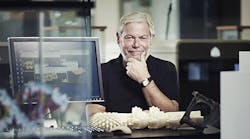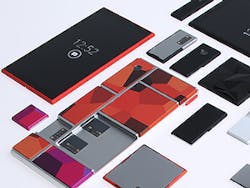Avi Reichental maintains a clear vision for the future of additive manufacturing: complete ubiquity.
Reichental doesn't see a future with 3-D printing in every home. He sees a future of a 3-D printer in every room of the home, churning out everything from breakfast to earrings, printing our every whim suited to our every fancy.
That's an ambitious vision, and one that really seems a little too fantastic or too sci-fi to believe.
But Reichental is serious, and so is his company.
Under his control, for the past 11 years, 3D Systems has attacked every market from industrial to consumer, creating machines designed to produce custom orthopedics, doll houses, art, jewelry, teeth, bones, candy, shoes, clay pots and everything in between.
Reichental, one could say, really is making machines to print our every whim.
Now, with a new deal signed with Google, he might be able to push it even further.
We recently caught up with Reichental to see where this project is going, where it will take the industry and why he is driving so hard to get it there.
Q: You've made it clear in the past that you want consumer-grade printers in every home, in every room in fact. Do you really think there is a demand for that level of customization in our daily lives?
A: I believe we have an inherent desire to differentiate. There is a preponderance of evidence for this, in how we cut our hair, what kind of attire we choose, what kind of cars we drive and how we accessorize and what kind of brands we identify with.
The industrial revolution eradicated all of this and convinced us that for access and economic benefit we can let go of our need to differentiate somewhat and conform into what comes off the rack.
Over the last 100 years, the shoemaking industry has convinced that we all conform into a shoe sizes from eight to 13.
They kind of forced us to endure all of the discomfort that comes with wearing the incorrect sizes.
The same is true for the eyewear industry. Show me one eyewear frame that actually fits really, really well on the bridge of your nose or within the distance of your temples.
And those are just the basic examples.
You can look at interior decorating elements, you can look at fashion, you can look at the industry of customizing your automobile and how big that has become in terms of what's available. Pimp your ride. It's over a $2 billion industry already.
These are all very powerful indications that there exists vast field of billions of ones of a kind that are today inaccessible or only accessible to those with slightly deeper pockets. Not everybody can afford to pimp their ride, but nonetheless is a multibillion-dollar industry already.
Very few people today could afford to have a custom pair of shoes made for them, but that does not need to be the reality in the future.
Custom Printed Life
Q: Where does 3-D printing fit in?
A: I see 3-D printing as not just the output device in terms of manifesting from the virtual to actual, but the entire digital thread that stitches it all together.
I see 3-D printing as both the ecosystem that connects you with what you want to do, to something that you can hold in your hand. It is the ecosystem or the platform to make that happen.
I see it also as the output device that allows you to manifest in the physical sense your ideas and your products.
And for these applications, it will be different printers. There will be a 3-D printer for your restaurant or your hospitality business that will likely print foodstuff and personalized nutrition.
There will be a 3-D printer maybe in your wardrobe closet that will print your fashion accessories and other elements of your personalized attire. There will be 3-D printers in may be community centers or Kinkos-like operations that will allow you to go and pick up elements that might not be economical for you to print at home.
Just like today, if I today need to print something simple like on my 2-D printer at home, but if I need to do a fancy presentation, I'm going to go down the street to a local FedEx store and get something full color or 10 copies of a nicely bound presentation book, and so forth.
So, that's the direction that I see 3-D printing going and I see it really as the official output device of the Internet of Things.
Q: Combining those two points, what's the value you are creating for the consumer? What will that do to the market?
A: I think in many ways, we're seeing an unleveling mass manufacturing and the ushering in of mass customization in ways that I think are going to be functionally beneficial, in the sense that you and I can be more comfortable and healthier walking in a bespoke pair of shoes than the off the rack ones. And in ways that I think would also engage the public with their favorite brand in a way that will be more meaningful and better because when you put a piece of your own creativity into what you wear or what you collect, what resides inside your home, it's much more meaningful to you and you develop more of an emotional level. Which I think will be priceless to those brands.
In the process, in due course, all of this will not only turn the economy of scale on its head, because for the first time you will be able to make in quantity of one or quantity of millions for the same price, but it will also turn on its head the traditional supply chain.
Printing Google
Q: Okay, let's turn to Google.
If it all works out, Google's Project Ara smartphone might be the most customizable, personalizable, mass produced good every manufactured.
It seems to be exactly the kind of think you're talking about, in fact. And of course you've been tapped to print it, antennas and all.
Could you tell me more about the project and your role in it?
A: It's an excellent example of taking this all to scale. Because with the Google Ara Project, Google's objective is to put this kind of phone in the hands of the remaining 5 billion people in the world who don't have a cell phone yet.
It's a project that takes it to scale and, in success, we're talking about printing tens of thousands of completely personalized phone module on a daily basis in which 3D Systems has two primary principle roles.
The first is to create the ecommerce capabilities for people to actually get online and what they want to order and then order it. This will be an online capability that will allow people to go online and configure what they want to do and place those orders for the modules, including their customized content that would be nicely gamified via app so that people could actually choose the color and the texture and the configuration, etc.
The second is the delivery of the first ever high speed continuous multi-material fiber grade system that will churn out thousands of cases daily, tens of thousands of cases daily, including not only the functional element, but also printing conductive elements like the antennas.
These are early examples of where we are taking the idea of mass customization, turning it to scale in terms of the mass component and truly to success in terms of creating the platforms and the online infrastructure to deliver gamified, customized content at scale.
In success, all of this will be available on the market sometime around the middle of next year and it will be a very powerful example of how we are leveraging human behavior and exponential technologies to really deliver from virtual to actual. A powerful example of what the internet of things will look like.
Q: And where do we go from there? After we have mass production of 3-D parts, what do we do with it? What's the end game?
What I've learned in decades of being alive and being a practitioner of technology and innovation and business is that there is no end game.
The end game is continuous improvement excellence in completely new horizons.
The other thing that I have learned is that in exponential time, things happen even faster.
Where do I see it going in the next few years?
I see 3-D printing as something that could potentially be more profound over time than, let's say the steam engine was in its day.
I see it one of the most powerful catalysts in the Internet of things.
There are some obvious uses. We mentioned those more profound uses in bio printing, in bio mimicry, in the era of creating really personalized nutrition and personalized medicine.
I see it as a very powerful ingredient in mashing together wearables and textiles into a very intelligent wearables that would allow not only for functionality but also for the sensing of vital signs, etc.
I also see it as part of creating an incredible exoskeleton devices that will be useful in everyday life in terms of strengthening us, allowing us to perhaps lift heavier objects, walk longer, exercise faster, increase our productivity and our infrastructure in ways that will go well beyond creating orthopedic and prosthetic devices of people. Really, it will get into everyday use in ways that could really enhance our performance and functionality.
These are not farfetched ideas. There is a great deal of research that has gone into this field and a great deal of science and technology that has already been developed.
It is an enabler that allows these technologies to be expressed in tangible ways.
Check out IW's complete "Take 5" series, a regular section featuring interviews with top executives.





